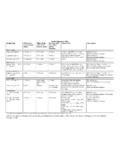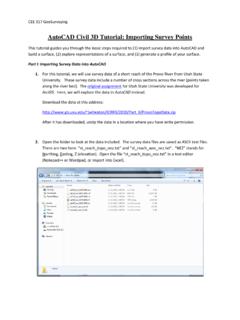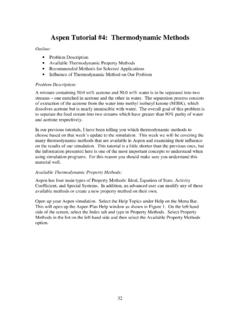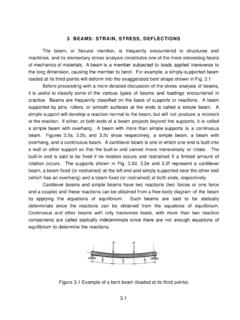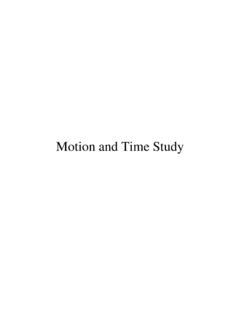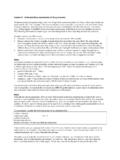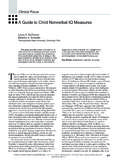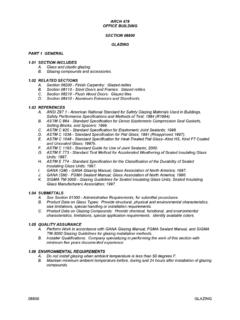Transcription of Actual Body Weight (ABW).
1 Lesson 4: calculations used to determine patient-specific doses The right dose General Dosing InformationDosing is one of the most common calculation functions that you will perform during your career. Dosing involvesa series of steps, each of which will potentially contain some calculations for you to do. It starts with someguidelines, usually a dosing range and from that calculating what amount of drug the patient should receive for eachdose, and how much total drug you will thus need to fill the patient s prescription. Let s look at each Locate dosing guidelines. You decide that you need to calculate a patient-specific dose. You must first locatesome dosing guidelines. You will find these guidelines in many common texts, and later on in your pharmaceutics,pharmacology, and therapeutics courses. Dosing guidelines will usually give you a range to choose from.
2 Some ofthese ranges will be total daily doses. For instance the pediatric guidelines for dosing amoxicillin, an antibiotic, foran ear infection, are 30-50 mg/kg/day, with the total daily dose given as three separate doses during the day. Otherranges will be per-dose. The adult dosing guidelines for gentamicin (an antibiotic), for instance are with doses commonly given every 8 hours. Cyclophosphamide, a medication given to cancer patients,can be dosed at 400-600 mg/m2 , using body surface area to create a patient-specific dose. The list could go on, buthopefully you get the Obtain patient variable data, such as Weight . After locating the dosing guidelines, you need to determine thevalue of the variable that the dose is dependent on: most commonly the patient s Weight , age, height, or kidneyfunction. Determining this may involve some detective work - you may have to ask the patient for his or her Weight ,for instance, or you may need to obtain a blood concentration of a substance (creatinine, a muscle breakdownproduct) in order to determine kidney Determine the patient-specific daily dosing range.
3 Once you have your dosing guidelines and the value, youwill likely have to multiply one by the other in order to get the dosing range for that individual patient. For instance,if you have a 20 kg child who is to receive amoxicillin, and you know that the dosing guidelines are 30-50mg/kg/day, it is a simple matter to determine that this patient should receive between 600 and 1000 mg ofamoxicillin Calculate the range for each patient-specific dose. If you have a daily dosing guideline, and the patient is toreceive more than one dose per day, you will need to divide the total daily dose by the number of doses/day. Forinstance, the patient who is to receive between 600 and 1000mg of amoxicillin per day is to have this medicationdivided evenly into three doses/day. This means that the patient should receive 200mg to 333mg in each do you do when you have no choice but to round up or down out of the dosing range?
4 In general, with anantibiotic it is better to round up than down. With all other medications it may be better to round down, rather thanup, although if you re just rounding up a little bit (10% or less), then you re probably OK rounding Determine an appropriate dosage form for the patient. Sometimes you will be given a dose of a drug that apatient is receiving in one form and will be asked to convert it to the dose a patient should receive in another example, if a patient is receiving a drug intravenously, he or she may need to have an oral dose calculated inorder to be eligible for discharge from the hospital. You will need to find some dose equivalency information inorder to do other time, you may initiate a change of dosage form yourself. Physicians may write for oral suspensions forchildren, but some children will prefer to take tablets.
5 If the patient is a child older than 5 years of age, it is best toask him or her whether or not he or she can swallow a tablet or would prefer liquid. Likewise, a physician may writea prescription for a particularly large dosage form for an elderly adult. If that patient has an impaired ability toswallow, for example if they ve had a stroke, then he or she may need an alternative dosage form. Let the patient orcaregiver guide you in your choice of dosage form whenever Choose an appropriate strength or concentration. Once you know the range for each dose, it is simply amatter of examining the strengths that a drug is available in and choosing one that is as simple as possible for thepatient to use. For example, amoxicillin comes in a concentration of 250mg/5ml and 125mg/5ml. Since 250mg is2between 200mg and 333mg, it would be easiest to have the parents administer 5ml (one teaspoonful) three times aday to the do you do if you calculate a specific strength or concentration and the drug is not available in that dose?
6 Inthat case, you need think carefully about the drug, the usual dosing methods, and the patient. Did the calculation youmade come close to the toxic range? If so, then choosing a lower dosage form may be the safest way to go. Orperhaps the drug can be dosed either once or twice daily and you find the dose you calculated can be easily split intotwo doses. If the drug can be dosed two or three times daily, would the patient be likely to miss that middle-of-the-day dose? These are only a few of several possible considerations that will depend upon the drug, the dose, thecalculation, and the patient. Generally speaking, if a dosage form is available that is within 10% of your calculateddose, then you re likely going to be fine with that dosage Calculate the total amount needed to fill the prescription. You will find that just because a prescriber writesthe amount to be dispensed on a prescription, that does not mean that this is the amount that you will end updispensing.
7 Insurance plans may specify a maximum number of days of medication that a patient can get, requiringyou to adjust the total amount of drug you fill. At other times the prescriber may not specify the total amount of drugto dispense (probably fed up with trying to second-guess insurance stipulations!) This should not be a problem foryou. When you know the exact amount of the drug that will be given per dose, you can calculate the amount withwhich to fill the prescription. Most antibiotics are given for a finite period of time ( 10 days), so you shouldsupply enough medication for the entire course of therapy. For our example above, the patient is to receive a 10days supply, so you will make sure the patient receives at least 150ml of amoxicillin suspension (5ml/dose x 3doses/day x 10 days = 150ml). For most suspensions and other liquid products, you may want to supply a smalladditional amount to account for spillage and for the suspension that clings to the side of the bottle and won t comeout.
8 In general, giving enough for one extra day of therapy is usually by Weight - an exampleA 10-year-old, 80-pound child is prescribed clindamycin, dose per Weight x 10 days, for treatment of a skin and Comparisons recommends 8-16mg/kg/day divided into 3 or 4 equal doses. You know that you shoulddose on the higher end to provide adequate penetration of an abscess. You carry clindamycin 150mg and 300mgcapsules in your pharmacy. what strength, quantity, and directions will you dispense?Clindamycin _____mg, #_____capsulesTake _____capsule(s) _____ times a mg/kg x 1 day x 80 lb x 1 kg = 97-194mg po TID or 73-145mg po QID day 3-4 doses 150mg, #30 capsulesTake 1 capsule 3 times a advice: dosage forms are made the size they are to facilitate use by the patient. If your calculated doseends up being 75 tablets or 250ml of liquid, or perhaps tablets or milliliters of a liquid, you can safelyassume that you did something wrong somewhere.
9 With some exceptions, patients will usually take 1-2 tablets orcapsules, or 1-2 teaspoonfuls, for each dose. Anything more or less than this, especially a lot more or a lot less,should alert you that you pearl: you cannot cut capsules in half. You can cut tablets in half, but that s a pain for the patient. Pleaseuse full dosage forms for tablets and capsules whenever Weight considerationsYou are probably quite deft by now at converting pounds to kilograms and back again. Congratulations! You arenow ready to consider some additional concepts regarding medication dosing that is done by Body Weight (ABW). This is a patient s real Weight . It is also called total body Weight (TBW)Ideal Body Weight (IBW). This is the Weight of our lean body mass (LBM): the Weight we would all really like tobe in our heart of hearts, and the Weight goal that fills gyms and aerobic classes each January with New Year sresoluteers.
10 You need to know about this because many medications are dosed based on a patient s IBW. Why?These are medications that do not distribute well into fat ( , hydrophilic drugs), and if you dosed an overweightpatient for a such a medication using ABW, you would end up overdosing the patient. The common equation usedfor calculating IBW is:male: 50kg + ( )(each inch > 5 ft) = IBW in kgfemale: 45kg + ( )(each inch > 5ft) = IBW in kgThe sooner you memorize these equations, the better. You will use them a lot in you know the patient s height in centimeters, you could use the following equation:male: 50kg + ( )(each cm > 152 cm) = IBW in kgfemale: 45kg + ( )(each cm > 152 cm) = IBW in kgIBW is also called lean body mass (LBM) or lean body Weight (LBW).What do you do if a patient is shorter than five feet tall? There are no published guidelines that I am aware of.

